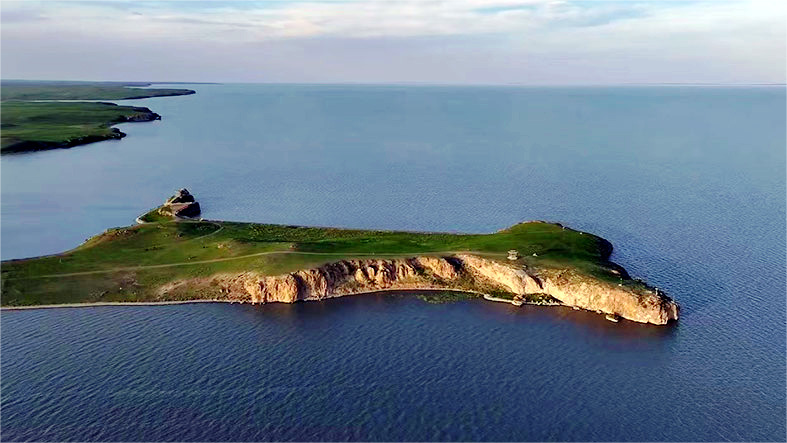3 Chinese sites listed as world geological heritages by IUGS
NANJING, Sept. 3 (Xinhua) -- Three geological sites in China, comprising vegetation fossils, dinosaur fossils and a karst landform, have recently been listed as Geological Heritage Sites by the International Union of Geological Sciences (IUGS).
These newly selected sites include the Permian vegetation of the Wuda Fossil Site in north China's Inner Mongolia Autonomous Region, the Dashanpu Middle Jurassic Dinosaur Fossils Site in southwest China's Sichuan Province and the Guilin Karst in south China's Guangxi Zhuang Autonomous Region, said Zhang Jianping, vice-chair of the IUGS International Commission on Geoheritage and a professor at the China University of Geosciences, Beijing, at a press conference held by the Nanjing Institute of Geology and Palaeontology under the Chinese Academy of Sciences (NIGPAS) on Tuesday.
So far, a total of 10 Chinese geological sites have been included in the list of the IUGS Geological Heritage Sites.
Geological heritages are a precious and non-renewable resource that faithfully records the 4.6 billion years of evolution history of the Earth and bases for geologists to conduct scientific research.
The IUGS Geological Heritage Sites are key places with the highest scientific international relevance, used as a global reference, and with a substantial contribution to the development of geological sciences through history, according to the IUGS.
The three newly selected sites are outstanding representatives of China's geological relics and they have been internationally recognized for their scientific value, research significance and current protection status, Zhang said.
VEGETATIONAL POMPEII
The Wuda Permian vegetation fossil site, dubbed the "Vegetational Pompeii," features a peat-forming tropical rainforest preserved in remarkable detail by volcanic ash. This ancient forest, dating back approximately 298 million years, was buried by ash-fall and now appears as a tuff bed between two coal seams in the Wuda coalfield, according to Wang Jun, director of NIGPAS.
The plant remains are well-preserved, with some retaining anatomical structures. The site provides extensive evidence of the intricate details of an ancient tropical rainforest community and interactions between various organisms, Wang said. "This site offers a unique window to understand past floral community ecology."
The Wuda fossil site is exceptional for best demonstrating what plants formed coal and what a coal-forming forest looked like, he added.
Discovered in 1998 and identified as a forest buried by ash in 2003, the site has since been studied by an international research team of about 30 experts from Britain, the United States, the Czech Republic, Germany and China, who have published over 60 research papers.
JURASSIC PARK
At the Dashanpu Middle Jurassic Dinosaur Fossils Site in Zigong City, Sichuan Province, over 200 specimens of dinosaurs and other vertebrates have been uncovered. According to Zeng Xiaoyun, curator of the Zigong Dinosaur Museum, these include 29 species across 26 genera, such as sauropods, theropods, basal neornithischians, stegosaurs, as well as fish, amphibians, turtles, crocodiles, pterosaurs and therapsids.
This site not only boasts the highest concentration of Middle Jurassic dinosaurs but also exhibits remarkable vertebrate diversity. Described by Zeng as a "Jurassic park," it is acclaimed as "a dinosaur quarry and a world wonder."
The site has yielded unique bone structures that are crucial for inferring dinosaur behaviors. It fills gaps in the history of dinosaur evolution and provides exceptionally valuable samples for studying dinosaurs from various perspectives and their relationships with other vertebrates, Zeng said.
The Dashanpu site, spanning an area of about 70,000 square meters, was first uncovered in 1972. An on-site museum was built thereafter. Extensive studies have been carried out by scientists from home and abroad.
KARST WITH SCIENTIFIC AND ARTISTIC VALUE
Guilin Karst features beautiful continental tower and cone karst formations around the Lijiang River and its tributaries, as well as many caves. Shaped by Paleozoic tectonic movements, the Guilin Karst has created a unique basin that is ideal for karst development, said Chen Weihai, deputy chief engineer of the Institute of Karst Geology of the China Geological Survey.
The geomorphological setting, enriched by thick carbonate deposits and a warm, humid climate with plentiful rainfall, fosters extensive karst phenomena. Guilin's geological stability and comparatively slow tectonic uplift, unlike more rapidly uplifting regions in the Yunnan-Guizhou Plateau, enhance its scientific relevance, making it an outstanding location for studying karst processes and their environmental impacts, Chen said.
Research on Guilin Karst dates back to the 17th century when the Chinese traveler and geographer Xu Xiake explored 88 caves. Contemporary studies focus on understanding karst dynamics and evolution models, as well as the aesthetic influence of Guilin's landscapes on Chinese paintings and poetry.
Photos
Related Stories
- China achieves remarkable results in protection, management of world natural heritage
- Trending in China | China's national intangible cultural heritage: Clay sculpture Ni Gugu
- 2nd Council Meeting of Alliance for Cultural Heritage in Asia held in Qingdao, China's Shandong
- Chinese team holds heritage protection class for Afghan students
- Researchers predict landslide displacement with satellite images, machine learning
Copyright © 2024 People's Daily Online. All Rights Reserved.









